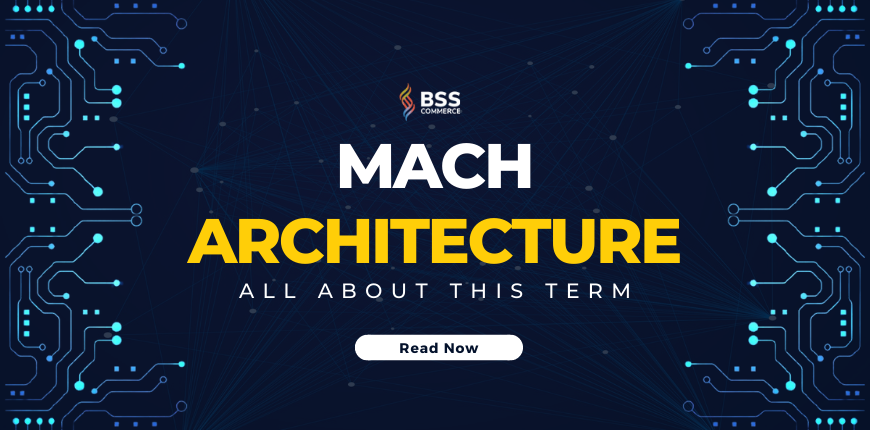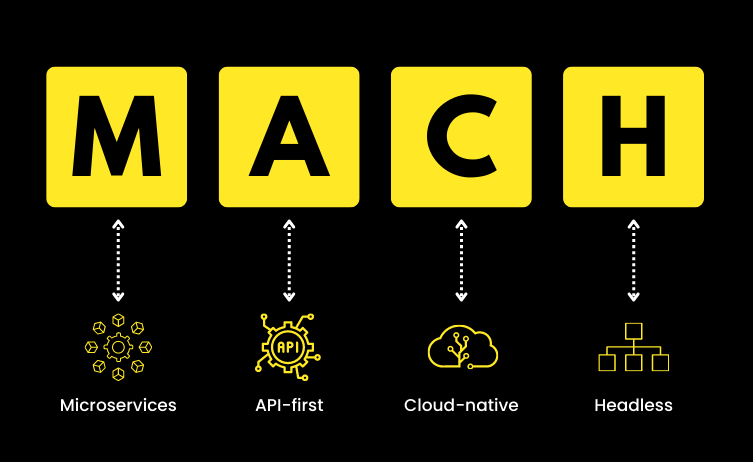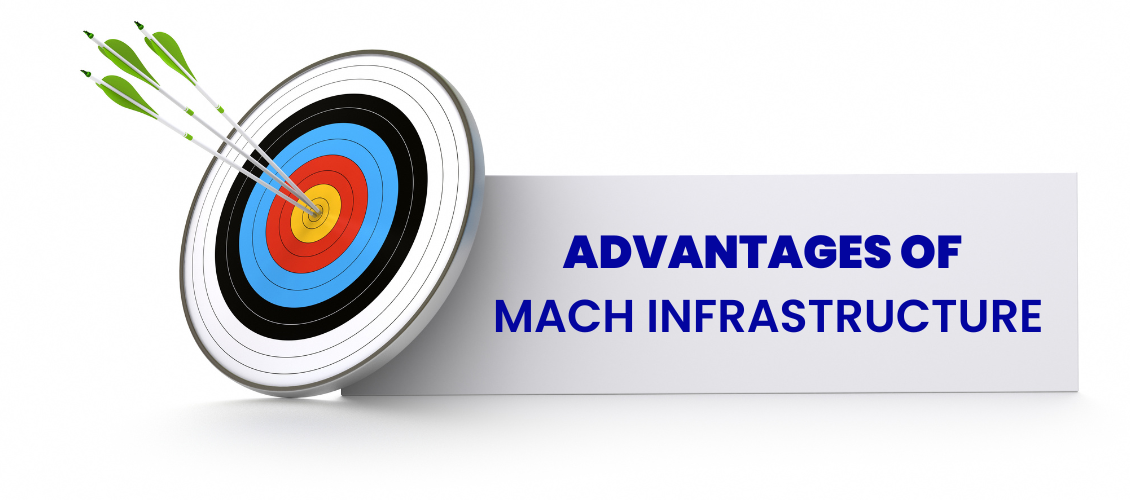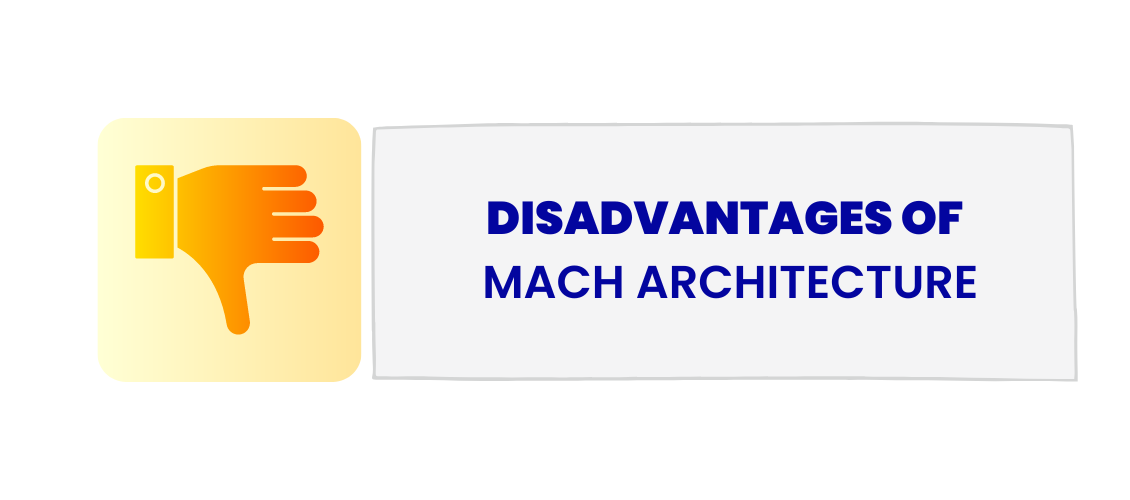MACH Architecture: State-Of-The-Art Technology

In this article, the term “MACH Architecture” is the main keyword. It is the most talked-about technology trend right now – solution enables companies to easily adapt to new technologies. Let’s take a closer look at why MACH is a popular trend and what it means.
Contents
Market Overview
The e-commerce industry is constantly evolving. That means new technologies are being generated and customers also have higher expectations.
Meanwhile, many traditional technologies are outdated, and rigid but still used as an essential element. That often clashes with the rapid development of technology and fails to meet new requirements.
As data grows in volume, monolithic platforms become more difficult to process and transport, causing system delays. On the other hand, cloud computing can assist you in tackling this challenge, with a CAGR of 17.5% expected by 2025.
Therefore, businesses must adapt to new environments with greater flexibility. They need to incorporate new technology and improvements into their system quickly. As a result, the architecture must transform from a monolithic model to one with interchangeable components.
This way allows businesses to develop new features and software faster and control all the functionality and relationships of other components in the structure.
What is MACH Architecture?

MACH architecture is the ideal solution for businesses that need to swiftly adapt themselves and their IT infrastructures to rapidly changing markets and consumer needs. It is a set of modernly technical principles, that stands for Microservices-based, API-first, Cloud-native, and Headless.
- Microservices: stand-alone applications inside the system are developed, deployed, and managed independently. A single microservice is designed to handle a particular task, such as product searches, checkout, wish lists, and so on.
- API-first: as a method to communicate between the backend and frontend. Via API, the data is gathered at dedicated backend microservices and transformed into a relevant frontend layer. It’s easy and simple to operate two or more separate applications together.
- Cloud-native: software is built and hosted in the cloud. Updates and upgrades happen automatically and quickly without customer work, downtime, licensing expenses, or other expenditures, so there’s no need for installation or maintenance.
- Headless: a separated architecture with the backend and the frontend being independent of each other. This architecture provides the ability to personalize customer experience without impacting the entire system.
MACH architecture can be understood as a one-size-fits-all system that delivers many features out-of-the-box. MACH architecture allows online merchants to break free from a single software provider or solution integrator and become independent.
Pros & Cons Of MACH Architecture
Being known as the solution for speeding up website and personalizing experience, which is looked for by almost merchants, let’s see the benefits and drawbacks this technology brings to your business!
The advantages of MACH infrastructure

Microservices
It is not technically essential to package new functions, patches, updates, and upgrades in more complete releases because individual microservices can be altered individually and independently of one another.
Iterations of business requirements can be swiftly generated and tested with the market thanks to the flexibility of APIs (build, measure, learn). Simultaneously, the IT stack remains adaptable, allowing it to respond to market developments on a continuous basis.
You can also create and refactor services yourself, or use a third-party solution to do so.
Headless and API-first
The headless method allows online merchants to create a platform that is both flexible and cost-effective. Front ends can consume data from an API without having to be vertically integrated through the entire technology stack.
As a result, businesses may develop new products, services, and business models more quickly, providing customers with more value.
Cloud-native
Cloud-native software can be used entirely through APIs, supports multi-tenancy, and manages the hosting and scaling of the underlying infrastructure.
Through systems with many data centers, you may use cloud-native apps to raise speed, reduce latency, and increase uptime. Furthermore, cloud-based solutions can assist you in auto-handling various feature upgrades, saving you time and effort.
The disadvantages of MACH architecture

Require professional qualification
Managing APIs also entails learning how different services interact and influence one another. This can be perplexing depending on the system’s complexity.
This necessitates maximal transparency and the flexibility to arrange APIs in a modular system to give the most functionality feasible.
Need longer time to give the final decision
Monolithic platforms have been around for a long time in the software industry and MACH architectures is still new.
Moving away from monoliths and toward more flexible models necessitates a shift in internal processes. These modifications are at least as significant as the technical changes and should not be overlooked.
Comparison: Traditional vs. MACH Architecture
The traditional system is often known as monolithic architecture – long-established technology. And MACH architecture seems to be the trend in this industry. So, why should you transform your system to MACH architecture instead of maintaining using the traditional technology? Let’s see specifically in the comparison table below!
| Architecture | Monolithic | MACH |
| Structure | Tight Coupling
The frontend and backend are tightly dependent. |
Headless Separation
The frontend and backend are separated, they work independently and communicate with each other thanks to the headless approach. |
| Flexibility | Inflexible
A single bug or update in the code might bring the entire system down. |
Highly flexible
Developers easily adjust (add, delete, update) or implement new services, designs, and models without disrupting the business. |
| Scalability | With the limit of system, merchants need the third-party to add any new functions. It won’t be able to scale as wished quickly. | It’s not necessary to buy or hire third party to scale new functions because merchants can modify the system. |
| Compatibility | One backend corresponds to one frontend. | One backend works well with multi-frontend via API. |
Big Benefits Of MACH Architecture

Decrease the risk for the entire system
Each component of the MACH architecture is self-contained. As a result, when developers modify one of them, the other areas are less affected. There is no capability leading collapsed whole system.
Furthermore, any upgrades are processed automatically without breaking and don’t interfere with the system’s integrity.
Cut time to launch new product
With this architecture, getting to MVP (minimum viable product) is shortened. Developers may quickly deploy prototypes, and organizations can validate essential concepts before investing in large-scale implementations, resulting in time and cost savings.
Implement a best-of-breed approach
By using the best technology – MACH infrastructure, the businesses are no longer forced to settle for less when it comes to software suites: they may add, test, and delete specific services at any moment.
Personalize user experience
Through APIs or headless, the data can deliver to various frontend layers with compatibility with all devices. Merchants can make immediate modifications to meet the needs of their customers. That optimizes customer experience, especially on mobile devices.
Save operating cost
Vendors can develop and host software in a cloud-native environment. It has a lower total cost than operating its own data center or cloud environment with its own 24/7 operations team at a hyperscaler.
MACH Architecture Examples
MACH architecture is the chosen technology of many big businesses. Two of them, the outstanding examples, are Amazon and Uber.
- Amazon: The leading business in transforming monolithic applications into microservices is called Amazon. This action has solved scaling customer database and user interface problems. Amazon would not have become the most valuable corporation in the world if it hadn’t transitioned to microservices, with a market capitalization of $941.19 billion on Feb. 28, 2020.
Amazon also uses headless commerce space by creating the Amazon Echo IoT device. They take advantage of a separated frontend and backend by deploying code every 11.7 seconds without disrupting service. They take advantage of a separated frontend and backend by deploying code every 11.7 seconds without disrupting service.

- Uber: Uber has done in switching the monolith into cloud-based microservices. Developers then created various microservices for functions such as passenger management, travel management, and more. And its microservices are connected via APIs

FAQs
1. What does “MACH” stand for?
MACH stands for 4 technical principles including:
- Microservices-based: allow merchants and developers to deploy, develop and manage every single function, design, and service independently.
- API-first: deliver the data between the backend and frontend of each other.
- Cloud-native: allow merchants to quickly scale up and down your cloud-based apps to meet business needs by hosting, building, storing, elastically scaling, and running applications in the cloud.
- Headless: support customizing the systems by adding, deleting, or changing specific services without disrupting the other parts.
2. Is MACH architecture suitable for only big businesses?
No, there are no conditions that show MACH is just for big business. Any merchant can switch to this advanced technology. If they have not budget enough, they can begin by simply changing a frontend and/or a Headless CMS first.
Conclusions
MACH architecture is the key to unlocking your company’s digital eCommerce future. All of the valuable benefits that this term brings to merchants are undeniable: more revenue, individualized experiences, improved website performance, system security, and more.
To avoid being stuck with outdated technology, business system restructuring should be addressed and done as soon as possible.
BSS Commerce is one of the leading Multi-platform eCommerce solution and web development services providers in the world. With experienced and certified developers, we commit to bring high-quality products and services to optimize your business effectively.
CONTACT NOW to let us know your problems. We are willing to support you every time.



